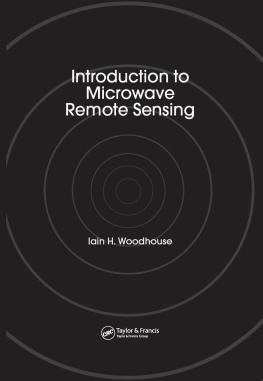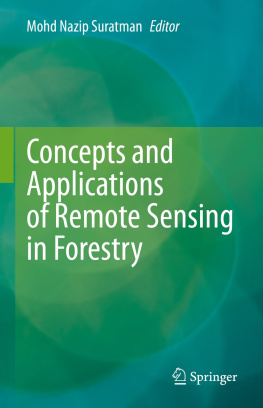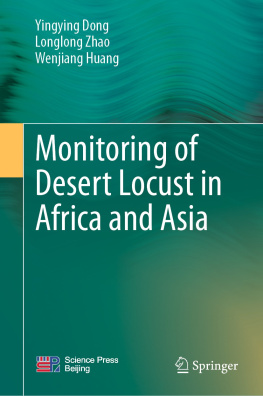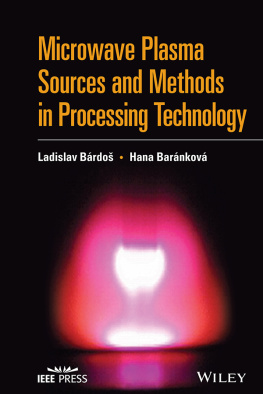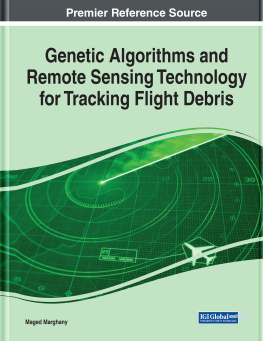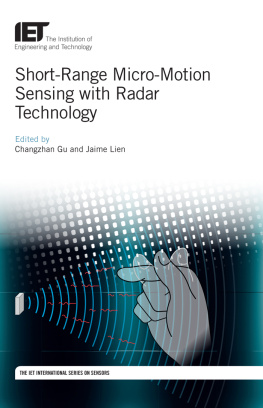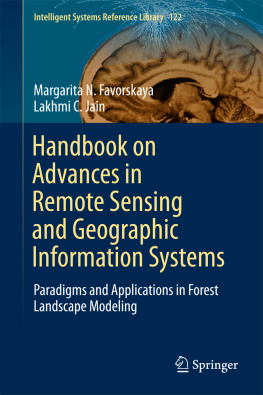Contents

Introduction to
Microwave
Remote Sensing
Introduction to
Microwave
Remote Sensing
Iain H. Woodhouse
The University of Edinburgh Scotland

Published in 2006 by
CRC Press
Taylor & Francis Group
6000 Broken Sound Parkway NW, Suite 300
Boca Raton, FL 33487-2742
2006 by Iain H. Woodhouse
CRC Press is an imprint of Taylor & Francis Group
No claim to original U.S. Government works
Printed in the United States of America on acid-free paper
10 9 8 7 6 5 4 3 2
International Standard Book Number-10: 0-415-27123-1 (Hardcover)
International Standard Book Number-13: 978-0-415-27123-3 (Hardcover)
Library of Congress Card Number 2005050635
This book contains information obtained from authentic and highly regarded sources. Reprinted material is quoted with permission, and sources are indicated. A wide variety of references are listed. Reasonable efforts have been made to publish reliable data and information, but the author and the publisher cannot assume responsibility for the validity of all materials or for the consequences of their use.
No part of this book may be reprinted, reproduced, transmitted, or utilized in any form by any electronic, mechanical, or other means, now known or hereafter invented, including photocopying, microfilming, and recording, or in any information storage or retrieval system, without written permission from the publishers.
For permission to photocopy or use material electronically from this work, please access www.copyright.com(http://www.copyright.com/) or contact the Copyright Clearance Center, Inc. (CCC) 222 Rosewood Drive, Danvers, MA 01923, 978-750-8400. CCC is a not-for-profit organization that provides licenses and registration for a variety of users. For organizations that have been granted a photocopy license by the CCC, a separate system of payment has been arranged.
Trademark Notice: Product or corporate names may be trademarks or registered trademarks, and are used only for identification and explanation without intent to infringe.
Library of Congress Cataloging-in-Publication Data
Woodhouse, Iain H.
Introduction to microwave remote sensing / Iain H. Woodhouse.
p. cm.
Includes bibliographical references and index.
ISBN 0-415-27123-1
1. Microwave remote sensing. I. Title.
G70.4.W66 2005
621.3678--dc222005050635

| Visit the Taylor & Francis Web site at http://www.taylorandfrancis.com and the CRC Press Web site at http://www.crcpress.com |
To my father, Hector Woodhouse, for bringing me up to know that science is fun.
foreword
Self Inductions in the air,
Everywhere, everywhere
Waves are running to and fro
Here they are, there they go
Try to stop em if you can
You British Engineering man!
Maxwell was only half a Maxwellian.
Oliver Heaviside, 1895.
New ideas take time to be accepted. Generations of scientists and engineers first need to re-examine basic assumptions, test theories and probe the limits of technology before maturity and clarity is obtained. Microwave Remote Sensing (MRS), the subject of this book, has arguably achieved this status and Iain Woodhouse presents use with a comprehensive and timely introduction to the topic.
The path to MRS leads all the way back to the fierce debate over the existence of electromagnetic waves in the late nineteenth century. In this case, time has demonstrated that the electromagnetic spectrum is a wide and wonderful natural resource and that our experience of it with our human senses is limited to a small band of optical frequencies. Our interpretation and observation of the world around us, both in qualitative and quantitative ways, tends to be governed by our reliance on our biological passive sensors, requiring the narrow filter of sunlight to see the world in colour and texture. Technology has changed all that. We can now devise our own sources of radiation with infinite subtlety, to view our environment and select the part of the spectrum best suited to our needs. In this way we can see through microwave eyes, or perhaps, as Iain Woodhouse suggests in this book, listen through microwave ears.
This is becoming increasingly important to our world. Issues like climate change, ozone depletion and ocean salinity are widely recognised as big problems for the future, whose solution requires international collaboration and a new global politics on a scale never before experienced by mankind. Microwaves provide an important window on these issues and, by exploiting their properties and developing new sensors and technologies, we can provide the sort of scientific data required by future generations to make the right decisions at the right time.
There is however one key problem, we cannot see these elusive microwaves and the technology to stop and collect them is both complicated and expensive. To add insult to injury, as Iain Woodhouse suggests, microwave images also require a new and different kind of interpretation to that used in our familiar optical spectrum. All of this tends to make MRS traditionally a rather arcane subject, often requiring years of advanced study and hence remaining solidly in the realm of the specialist engineer, physicist or more recently, radar applications scientist. All of this will change in the future and this book is a bold attempt to provide a comprehensive survey of the field at a level accessible to many. It is built on a solid understanding of the physics behind microwave interactions but is presented in a readable and descriptive manner. It provides a unique blend of historical context, basic physical principles and applications science. It covers the full range of applications and details numerous examples of the successful application of microwaves in remote sensing. It ranges in coverage from the earliest attempts at microwave radiometry through to the very latest techniques for producing high-resolution global scale microwave radar images. Importantly it is one of the first texts to provide a clear exposition of the development of radar polarimetry and interferometry, two new technologies whose fusion promises much for the future. As alluded to above, technology forecasting is a dangerous process but this book provides a timely and informative review of an important subject in the toolbox of remote sensing. The reader will not only gain valuable insight into the principles behind microwave sensors but also achieve a deeper understanding and appreciation of this important technology.
Shane R Cloude
University of Adelaide, Australia
preface
Theres good news and theres bad news.
The bad news is that microwave remote sensing is a difficult subject. It requires a fair bit of mathematics and physics to be able to understand many of the topics and there are many novel concepts that will seem rather difficult to grasp first time around. Coherence. Polarimetry. Interference. If these are new to you, then dont panic. They are difficult concepts and will take a while to get used to. But remember: perseverance furthers.
As my contribution, Ive tried to make sure that the more challenging material can be skimmed over without loss of consistency in the rest of the text. There are more words than equations in this text. Ive done that to put the emphasis on ideas and concepts, rather than the detailed physics behind them. But sooner or later, if you want to truly get to grips with microwave remote sensing, you will have to tackle some mathematics and basic physics.

